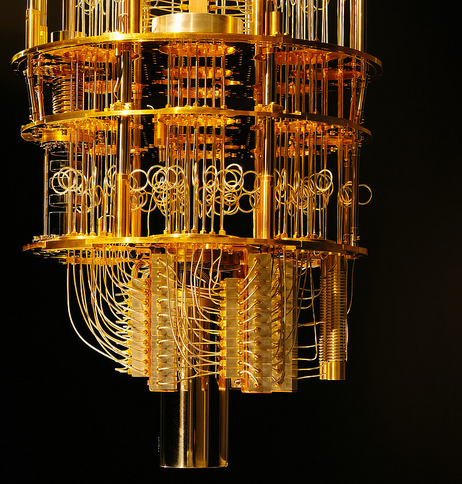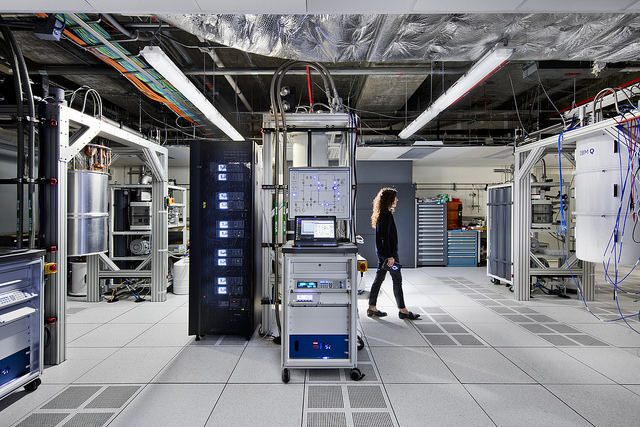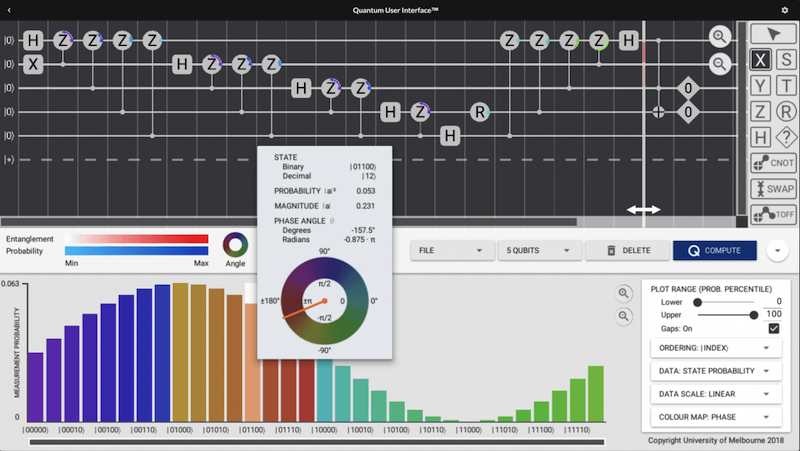IBM Quantum Hub at the
University of Melbourne
The IBM Quantum Hub at the University of Melbourne offers a complete approach for Members to gain early entry into quantum computing with the support of deep research expertise and the global quantum community.
A new way of thinking
Quantum computing is moving rapidly from proof-of-concept to practical applications in science and business. Developing at a breathtaking pace, we are witnessing a period of evolving interaction between researchers and application developers.
Harnessing the creativity to drive commercial applications will depend on new thinking and new software, developed in parallel with the advancing power and reliability of quantum computing hardware. Early-adopters who drive the development of quantum software in their field will benefit from a strong IP position that will be hard for fast-followers to challenge or replicate.


Australia's only University-based IBM Quantum Hub
Led by Professor Lloyd Hollenberg in collaboration with IBM, the University of Melbourne is the sole university-based IBM Quantum Hub in Australia and New Zealand. The team has worked in quantum computing for some two decades – during this time they have created the blueprint for a full-scale silicon quantum computer and recently set a world record for quantum entanglement on IBM Quantum devices. Through the Quantum Hub, the team is at the forefront of research into practical quantum computing.
In 2018, the team launched the web-based Quantum User Interface (QUI) – a quantum computer simulation environment for software development and training the new generation of quantum programmers.
Quantum computer technology will evolve rapidly, with members of the Quantum Hub at Melbourne positioned to direct that future, working on IBM’s most powerful quantum computers to develop software and expertise for the benefit of their sector and broader society. Professor Lloyd Hollenberg
IBM Quantum is advanced quantum cloud technology – several real quantum computer devices and simulators available for use through the cloud – enabling Fortune 500 companies, startups, national research labs and academic institutions to run experiments and explore use cases.
These devices are part of the IBM Quantum roadmap, an initiative to build universal quantum computers for business and science. Find out more at ibm.com/quantum-computing.
Foundations of quantum technology
Quantum bits or qubits are quantum mechanical systems, like the state of a single atom or even a microscopic superconducting circuit. Classical computing works with bits, and a bit can only ever be 0 or 1. Qubits can be effectively both 0 and 1 at the same time.
This quality of qubits, called quantum superposition, together with the related phenomenon of entanglement, is where the remarkable increase in computing power begins.
As the number of qubits grow, superposition allows the quantum computer to represent exponentially increasing sets of numbers. To get a sense of what this means, imagine putting one grain of rice on the first square of a chessboard. Now double that number on each square and by the end of the board you’ll have 92 billion tonnes of rice.
Carefully choreographed sequences of quantum logic gates – the quantum software program – manipulate superposition and entanglement across the vast array of quantum information, to expand computational power.

How does IBM Quantum help research and development?

There are problems that today’s computer systems will never be able to solve, such as accurately simulating large interacting systems, or solving certain optimisation and machine learning challenges. These kinds of problems get exponentially harder as complexity grows even a little, and for problems above a certain size classical computer systems simply run out of steam.
However, quantum computers working alongside classical computers may provide solutions. See the potential near-term applications for quantum computing.
Like the early stages of the digital revolution when no one could imagine how finance or logistics – or the very rhythms of daily life, would be transformed – we can’t yet predict where quantum computing will bring the greatest advantages.
Potential near-term applications for quantum computing
The first business use cases for quantum computing have yet to be determined. They may include, but are not limited to:
- Pharma and Materials, untangling complex molecular and chemical interactions to discover new drugs and materials
- Supply Chain and Logistics, finding solutions for more efficient logistics and global supply chains
- Financial Services, finding new ways to model financial data and isolate risk factors to make better investments
- Artificial Intelligence, enhancing machine learning, hybrid quantum approaches to data classification.

At the Quantum Hub, staff and students are engaged in a range of research projects, spanning fundamentals of quantum information and quantum physics of IBM devices, through to applications in a number of areas.
Research themes
Applications of quantum computing: traffic optimisation and routing, machine learning, materials, chemistry, finance, bioinformatics and cybersecurity.
Science of quantum computing: large-scale entanglement, logic gate characterisation and improvement, HPC benchmarking, and quantum error mitigation.
Recent Quantum Hub papers
"Noise-robust ground state energy estimates from deep quantum circuits"
Harish J. Vallury, Michael A. Jones, Gregory A. L. White, Floyd M. Creevey, Charles D. Hill, Lloyd C. L. Hollenberg
Quantum (2023)
"Boosted Ensembles of Qubit and Continuous Variable Quantum Support Vector Machines for B Meson Flavour Tagging"
Maxwell T. West, Martin Sevior, Muhammad Usman
Advanced Quantum Technologies (2023)
"Reflection Equivariant Quantum Neural Networks for Enhanced Image Classification"
Maxwell West, Martin Sevior, Muhammad Usman
Machine Learning: Science and Technology (2023)
"GASP: a genetic algorithm for state preparation on quantum computers"
Floyd M. Creevy, Charles D. Hill, Lloyd C. L. Hollenberg
Scientific Reports (2023)
"Towards quantum enhanced adversarial robustness in machine learning"
Maxwell T. West, Shu-Lok Tsang, Jia S. Low, Charles D. Hill, Christopher Leckie, Lloyd C. L. Hollenberg, Sarah M. Erfani, Muhammad Usman
Nature Machine Intelligence (2023)
"Quantum computing: a new paradigm for ecology"
Andrew P. Woolnough, Lloyd C. L. Hollenberg, Phillip Cassey, Thomas A. A. Prowse
Trends in Ecology & Evolution (2023)
"Permutation invariant encodings for quantum machine learning with point cloud data"
Jamie Heredge, Charles D. Hill, Lloyd C. L. Hollenberg, Martin Sevior
https://arxiv.org/abs/2304.03601 (2023)
"Benchmarking adversarially robust quantum machine learning at scale"
Maxwell T. West, Sarah M. Erfani, Christopher Leckie, Martin Sevior, Lloyd C. L. Hollenberg, Muhammad Usman
Physical Review Research (2023)
"Automated Quantum Circuit Design With Nested Monte Carlo Tree Search"
Peiyong Wang, Muhammad Usman, Udaya Parampalli, Lloyd C. L. Hollenberg, Casey R. Myers
IEEE Transactions on Quantum Engineering (2023)
"A scalable and fast artificial neural network syndrome decoder for surface codes"
Spiro Gicev, Lloyd C. L. Hollenberg, Muhammad Usman
Quantum (2023)
"A kernel-based quantum random forest for improved classification"
Maiyuren Srikumar, Charles D. Hill, Lloyd C. L. Hollenberg
https://arxiv.org/abs/2210.02355 (2023)
"Realization of a discrete time crystal on 57 qubits of a quantum computer"
Philipp Frey and Stephan Rachel
Science Advances, Vol 8, Issue 9 (2022)
Featured in The Conversation and Pursuit.
"Chemistry beyond the Hartree-Fock limit via quantum computed moments"
Michael A. Jones, Harish J. Vallury, Charles D. Hill, Lloyd C. L. Hollenberg
Scientific Reports (2022)
"From many-body to many-time physics"
Gregory A. L. White, Felix A. Pollock, Lloyd C. L. Hollenberg, Charles D. Hill, Kavan Modi
https://arxiv.org/abs/2107.13934 (2022)
"Clustering and enhanced classification using a hybrid quantum autoencoder"
Maiyuren Srikumar, Charles D. Hill, Lloyd C. L. Hollenberg
Quantum Science and Technology (2022)
"Non-Markovian Quantum Process Tomography"
Gregory A. L. White, Felix A. Pollock, Lloyd C. L. Hollenberg, Kavan Modi, Charles D. Hill
PRX Quantum (2022)
"Process Tomography on a 7-Qubit Quantum Processor via Tensor Network Contraction Path Finding"
Aidan Dang, Gregory A. L. White, Lloyd C. L. Hollenberg, Charles D. Hill
https://arxiv.org/abs/2112.06364 (2021)
"Truncated phase-based quantum arithmetic: error propagation and resource reduction"
G. A. L. White, C. D. Hill, L. C. L. Hollenberg
https://arxiv.org/abs/2110.00217 (2021)
"Quantum Support Vector Machines for Continuum Suppression in B Meson Decays"
Jamie Heredge, Charles Hill, Lloyd Hollenberg, Martin Sevior
Computing and Software for Big Science (2021)
"Whole-device entanglement in a 65-qubit superconducting quantum computer"
Gary J. Mooney, Gregory A. L. White, Charles D. Hill, Lloyd C. L. Hollenberg
Advanced Quantum Technologies (2021)
Featured in IBM Research Blog.
"Generation and verification of 27-qubit Greenberger-Horne-Zeilinger states in a superconducting quantum computer"
Gary J. Mooney, Gregory A. L. White, Charles D. Hill, Lloyd C. L. Hollenberg
Journal of Physics Communications (2021)
Featured in IBM Research Blog.
“Performance optimisation for drift-robust fidelity improvement of two-qubit gates”
Gregory A. L. White, Charles D. Hill, Lloyd C. L. Hollenberg
Phys. Rev. Applied, 15, 014023 (2021)
"Cost optimal gate synthesis in the Clifford hierarchy"
Gary J. Mooney, Charles D. Hill, Lloyd C. L. Hollenberg
Quantum 5, 396 (2021).
“Experimental non-Markovian process characterisation and control on a quantum processor”
Gregory A. L. White, Felix A. Pollock, Charles D. Hill, Lloyd C. L. Hollenberg, Kavan Modi
Nature Communications, 11, 6301 (2020)
“Quantum computed moments correction to variational estimates”
Harish Vallury, Michael Jones, Charles Hill and Lloyd Hollenberg
Quantum 4, 373 (2020)
“Entanglement in a 20-Qubit Superconducting Quantum Computer”
Gary Mooney, Charles Hill and Lloyd Hollenberg
Scientific Reports 9, 13465 (2019)
Quantum User Interface
The Hollenberg group has developed a sophisticated quantum computer simulation tool – the Quantum User Interface (QUI) – for use in research and teaching.
The QUI system is integrated into the following subjects:

The IBM Quantum Hub at the University of Melbourne is the only university-based Quantum Hub in Australia and New Zealand. The team has decades of combined expertise in the field of quantum computing.
Academics
| Prof Lloyd Hollenberg (Physics) – Q Hub Director | Prof Udaya Parampalli (Computer Science) |
| Dr Gary Mooney (Physics) | Dr Thomas Quella (Mathematics and Statistics) |
| Prof Kate Smith-Miles (Mathematics and Statistics) | A Prof Stephan Rachel (Physics) |
| Dr Usman Muhammad (Computer Science) | Prof Martin Sevior (Physics) |
| Prof Carsten Murawski (Finance) | Dr Nitin Yadev (Finance) |
| Dr Eric Mascot (Physics) |
Collaborators
| Dr Kavan Modi (Physics, Monash University) |
| Dr Bhaskar Roy Bardhan (Research & Advanced Engineering, Ford Motor Company) |
Student Researchers
| Aidan Dang (PhD, Physics) | Ben Harper (PhD, Physics) |
| Chris Nakhl (MSc, Physics) | Fanzhe Qu (MSc, CIS) |
| Floyd Creevey (PhD, Physics) | Gregory White (PhD, Physics) |
| Haiyue Kang (MSc, Physics) | Harish Vallury (PhD, Physics) |
| James Nelson (MSc, Mathematics) | Jamie Heredge (PhD, Physics) |
| Jedwin Villaneuva (MSc, Physics) | John Kam (MSc, Physics) |
| Maiyuren Srikumar (PhD, Physics) | Michael Jones (PhD, Physics) |
| Peiyong Wang (PhD, CIS) | Philipp Frey (PhD, Physics) |
| Sarama Tonetto (PhD, Physics) | Shaobo Zhang (PhD, CIS) |
| Vivek Katial (PhD, Mathematics) |